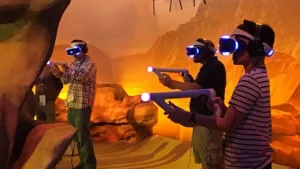After years of prototypes, demonstrations and teasers, we are finally on the cusp of virtual reality going mainstream. The evidence was seen at E3 this month, where VR was demonstrated by companies including Sony, Bethesda, Square Enix and Microsoft. However, for all its promise, VR still has its own unique problems.

Every major player (bar Nintendo, which has always done its own thing) promised VR of some sort in 2017. Microsoft announced Project Scorpio (Microsoft Rises to Challenge of UHD & HDR Gaming), while Sony confirmed that it would release a ‘mid-generation’ Playstation 4 console that will support VR (UHD Playstation is Official – But…). There was also support in the PC gaming space, with titles announced for the HTC Vive, Oculus Rift and Gear VR.
Sony, undoubtedly, dominated the announcements. Not only did the company share an official release date and price for its PSVR headset (see link above); it also said that there will be 50 games by the end of this year. Trailers shown included Capcom’s Resident Evil VII, Square-Enix’s Final Fantasy XV and a new mission for Star Wars Battlefront.
 This is where we encounter the first of the problems with VR: movement. All accounts say that those trying the REVII demonstration experienced extreme feelings of motion sickness. This was largely because the direction of the character’s head can be controlled through a gamepad, rather than simply looking around (this is also an option, but the habit for long-time Resident Evil players turned out to be hard to break). The disconnect between what your eyes and feet are telling you – are you moving or not? – made Engadget‘s Jess Condit feel like she “was going to puke all over Sony’s media lounge.” Read her account here: http://tinyurl.com/jfycuf7.
This is where we encounter the first of the problems with VR: movement. All accounts say that those trying the REVII demonstration experienced extreme feelings of motion sickness. This was largely because the direction of the character’s head can be controlled through a gamepad, rather than simply looking around (this is also an option, but the habit for long-time Resident Evil players turned out to be hard to break). The disconnect between what your eyes and feet are telling you – are you moving or not? – made Engadget‘s Jess Condit feel like she “was going to puke all over Sony’s media lounge.” Read her account here: http://tinyurl.com/jfycuf7.
For years, movement in VR has either been on-rails or controlled by the player ‘walking’ on a rolling platform. There were several new approaches at E3, though, which do show a step forward (sorry) in the space.
Several games, like Final Fantasy, Doom and Fallout, allowed the player to teleport around the game area – a good solution but one which, as Cnet noted, kills immersion. It’s also simply not viable at certain points in these games: anything requiring very fast footwork, for example. Another game – Impulse Gear’s Farpoint – used a different approach, which required a brand new controller (the Playstation VR Aim).
The perfect system for virtual movement has not been hit upon yet. I can imagine the HTC Vive, for example, using its external sensors to track player movement in the real world, but this wouldn’t work for Sony’s PSVR.
‘Farpoint’ required a brand new Playstation controller peripheralCapcom’s Resident Evil game threw up another issue, which is unique to the PSVR: framerate. The headset is supposed to promote mainstream adoption of virtual reality; to that point, it both costs less and has lower minimum specifications for games than products like the Rift or Vive. Games must run at a minimum of 60fps, rather than the 90fps enforced on higher-end platforms. Frame dropping and response lag can completely disrupt the flow of an otherwise-immersive experience.
While Capcom has said that the REVII is still under development – and controls and framerate can change in that time, of course – Sony has set a dangerously low bar for entry to the VR space. Oculus founder Palmer Luckey warned two years ago, “When VR arrives, it has to be good…[R]eally bad VR is the only thing that can kill off VR.”
Speaking of Oculus, the company spent the majority of E3 being criticised for buying the rights to certain titles, in order to make them exclusive to the Oculus Rift. It is a maxim of the gaming industry that exclusive titles are hated by gamers, and Oculus’s move opens up a ‘can of worms’: the PC has never been a ground for exclusive titles, like consoles have. If a PC can run a game, it can play that game. The company, like Sony, is setting a dangerous precedent.
All of that said, we are at an exciting time in the gaming space, which is set to be one of, if not the, most popular applications for consumer virtual reality in its initial years. We have major companies developing new consoles with the specific intent of running VR titles; studios that have been operating for decades are porting their most well-loved franchises to the format; and other firms are dedicated to solving the problems of VR interaction and movement. It will be fascinating to see what experiences are developed next.

